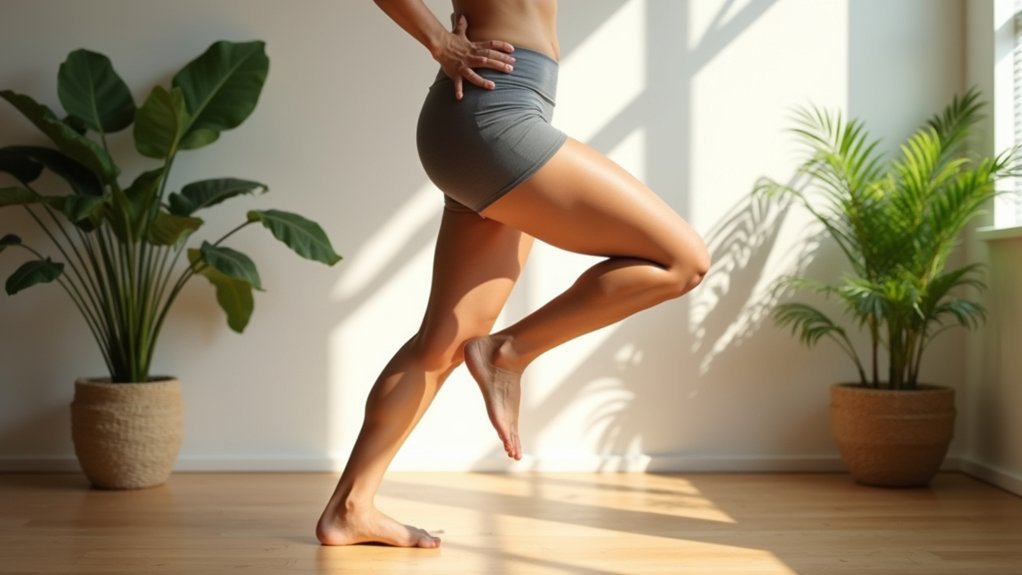Stimulate your lymphatic system with these powerful detox moves: deep diaphragmatic breathing, shoulder rolls, ankle circles, seated twists, foam rolling, rhythmic heel lifts, gentle rebounding, knee lifts, upper body twists, and arm circles. Perform these for 10 minutes daily, 3-5 times weekly, starting with just 2-5 minutes if you’re new. Progress gradually by adding arm movements and increasing duration. These techniques create the perfect formula for improved circulation and toxin removal throughout your body.
10 Best Lymphatic Detox Moves For Circulation

Five powerful movement categories can dramatically improve your lymphatic circulation and enhance your body’s natural detoxification process.
Deep diaphragmatic breathing creates essential pressure changes that stimulate lymph flow, especially when using the 4-7-8 pattern or combining with arm raises.
Your breath holds the key—with each mindful 4-7-8 inhalation, you’re activating nature’s detox pump and setting lymphatic flow in motion.
Upper body activations like shoulder rolls and wall push-ups target supraclavicular nodes and axillary drainage.
For lower body engagement, incorporate ankle circles, knee lifts, and calf raises to activate inguinal nodes and engage muscle pumps. Muscle contractions serve as a natural pump that propels lymph fluid through your system.
Full-body movements provide systemic benefits—try seated twists, brisk walking, or yoga cat-cow flows to create thoracic fluid shifts.
After exercising, don’t skip post-movement protocols. Static stretching, foam rolling, and proper hydration prevent fluid stagnation while supporting your body’s detoxification efforts.
Gentle Bounce Technique for Lymphatic Activation
You don’t need fancy equipment to start lymphatic activation through gentle bouncing—simply focus on shifting your weight from foot to foot while standing or practice mini-jumps on a carpeted surface.
For best results, aim to bounce consistently for 10-15 minutes daily, though you can split this into shorter sessions throughout the day if needed.
Begin with the gentlest movements possible, gradually increasing your bounce height and adding lateral movements as your comfort and strength improve. These movements are particularly beneficial as they help remove toxins and support overall lymphatic system function.
Equipment-Free Bouncing Options
When your fitness toolkit lacks specialized equipment, gentle bouncing techniques offer an accessible pathway to lymphatic health without fancy gadgets or gym access.
You’ll need just a small 3×3 foot space to perform these effective movements.
Try alternating heel lifts while standing to create rhythmic gravitational shifts that activate your lymphatic system. Use your doorframe for stability during micro-bounces, or hold a chair back while gently bouncing on the balls of your feet. These simple movements create rapid gravity changes that effectively stimulate lymph circulation throughout your body.
Even seated, you can tap toes or lift heels rhythmically to engage your calf muscle pump. For enhanced benefits, go barefoot on carpet or a yoga mat to maximize sensory feedback.
Sync your movements with your breath—inhale up, exhale down—and maintain a neutral spine to prevent improper muscle recruitment during each lift.
Optimal Bouncing Duration
Finding the right bouncing duration balances effectiveness with sustainability for your lymphatic system. Aim for at least 10 minutes per session, 3-5 times weekly, to maximize lymphatic benefits at moderate intensity.
Start with just 2-5 minutes initially, allowing your body to adapt to the increased gravitational load. Even these brief sessions can considerably flush your lymphatic system and temporarily boost white blood cell count. Research shows that white blood count triples during rebounding sessions, enhancing your immune response capacity.
As your body adjusts, gradually increase your time. The gentle bouncing action creates G-forces that activate one-way lymphatic valves, enhancing circulation and detoxification.
This motion helps strengthen your bones and internal organs while improving central lymphatic flow. For ideal results, maintain consistent rebounding sessions rather than occasional intense workouts.
Progressive Intensity Protocol
Developing an effective progressive intensity protocol requires understanding the gentle bounce technique that maximizes lymphatic activation without overtaxing your system. Begin with short sessions of gentle heel lifts and gradually incorporate more complex movements as your body adapts. The best approach incorporates rhythmic movements with light pressure, similar to the principle techniques used in Manual Lymphatic Drainage therapy.
| Phase | Duration | Technique | Goal |
|---|---|---|---|
| I (Weeks 1-2) | 2-3 minutes daily | Stationary heel taps | Establish baseline lymph flow |
| II (Weeks 3-4) | 5-6 minutes daily | Add heel twist motions | Enhance multi-directional drainage |
| III (Weeks 5-6) | 8-10 minutes daily | Synchronize arm raises | Activate upper body lymphatics |
| IV (Weeks 7+) | 10-15 minutes daily | Introduce slight knee bends | Maximize whole-body circulation |
Remember to maintain a consistent 1-2 inch bounce height and limit frequency to 1-2 Hz. You’ll achieve better results by increasing session frequency rather than bounce amplitude or intensity.
Rhythmic Heel Bounces to Stimulate Lower Body Drainage
Bounce your way to better lymphatic health with rhythmic heel movements that naturally stimulate your body’s drainage system. These gentle 1-2 inch heel lifts create gravitational shifts that activate lymphatic valves while engaging your calf muscles to pump fluid upward.
For maximum benefit, perform barefoot on a supportive surface for 10-20 minutes at a steady tempo (60-80 bpm). Since the lymphatic system lacks a central pump, these repetitive bouncing motions serve as the driving force for circulation. Exhale as you lift, maintaining neutral spine alignment and staying well-hydrated.
The rhythmic motion targets key lymph nodes in your groin, behind your knees, and throughout your abdomen.
Start with 50 bounces daily and gradually progress to 100 reps. This consistent practice accelerates toxin removal, reduces swelling, and enhances immune function by increasing lymphocyte circulation throughout your body.
Upper Body Twists on the Rebounder for Thoracic Flow

While performing upper body twists on the rebounder, you’ll maximize lymphatic benefits by incorporating cross-body motions that specifically target your thoracic region.
Start with gentle bounces and progressively increase intensity as your comfort and stability improve over time. For increased efficacy, combine these movements with high knee lifts that elevate your heart rate and enhance overall circulation.
Your form is essential—keep your core engaged, spine aligned, and movements controlled to guarantee effective lymphatic flow without risking injury.
Cross-Body Motion Benefits
As you engage in upper body twists on the rebounder, your thoracic lymphatic system springs into action, creating a powerful detoxification effect. The twisting motion targets lymph nodes near your armpits and collarbones, potentially increasing flow up to 10 times normal rates. Unlike traditional massage, these movements use light pressure that’s ideal for the lymphatic vessels located just beneath the skin.
The combination of vertical bouncing and horizontal twisting creates a 3D stimulation that maximizes lymph movement throughout your upper body.
| Benefit | How It Works |
|---|---|
| Thoracic Lymph Activation | Stimulates vessels near armpits/collarbones |
| Diastolic Compression | Creates suction-like effect on lymph fluid |
| Multiplanar Mobilization | Addresses horizontal and vertical vessel pathways |
| Neuromuscular Coordination | Challenges core while improving breathing patterns |
| Metabolic Waste Export | Accelerates toxin removal through node filtration |
This cross-body motion counteracts the lymph stagnation common with sedentary postures while protecting your joints.
Progressive Bounce Intensity
Progressive intensity on the rebounder transforms ordinary bouncing into a potent lymphatic catalyst. By gradually increasing your bounce height, you’ll generate stronger G-forces that stimulate the one-way valves in your lymphatic system, accelerating toxin removal. The one-way valves open and close with each bounce, enhancing lymphatic drainage throughout your body.
Adding upper body twists while rebounding expands your thoracic cavity, enhancing circulation through your chest and shoulders. These twists improve posture by stretching your thoracic spine while simultaneously toning upper body muscles.
Start with gentle bounces and gradually increase intensity, always listening to your body. Incorporate interval patterns by alternating between high and low bounces with twists for maximum effectiveness.
This progression not only strengthens your heart and increases capillary formation but also improves your balance and coordination by enhancing nerve impulse transmission between muscles.
Form Matters Most
Mastering proper form during upper body twists on the rebounder isn’t just beneficial—it’s essential for maximizing lymphatic drainage in your thoracic region.
Perform twists slowly and with control, exhaling as you rotate and inhaling when returning to center.
Keep your posture upright with engaged core muscles to support your spine and prevent strain. This targeted movement enhances thoracic lymphatic flow while flushing toxins from your system.
As you become comfortable, gradually increase your range of motion to improve flexibility and circulation.
The beauty of combining rebounding with twisting motions lies in its low-impact nature—you’ll stimulate lymphatic flow without stressing your joints.
This efficient technique not only supports detoxification but also strengthens your core and improves respiratory function, making it a powerful addition to your lymphatic health routine. The low-impact exercise helps protect your joints while effectively promoting lymphatic movement throughout your body.
Alternating Knee Lifts for Deep Abdominal Lymph Nodes

Three powerful mechanisms make alternating knee lifts an essential movement for lymphatic detoxification.
First, the rhythmic compression and release pattern stimulates deep abdominal nodes, propelling lymph fluid toward the thoracic duct.
Second, the vertical motion leverages gravity to enhance flow while engaging your hip flexors and core.
Third, the movement creates ideal intra-abdominal pressure changes that flush metabolic waste.
To perform correctly, stand tall with your spine aligned and core engaged.
Inhale as you lift one knee to chest height (2 seconds), hold briefly, then exhale while lowering (3 seconds).
Maintain an upright torso throughout.
Complete 10-15 repetitions per leg, 2-3 times daily for therapeutic effect.
Start seated if needed, then progress to standing.
This low-impact exercise delivers significant detoxification benefits while being gentle on your joints. This gentle approach is especially beneficial as muscle contractions help move stagnant lymphatic fluid through the system.
Lateral Bounce Variations to Target Side-Body Channels
Energize your lymphatic system with alternating side hops that create a gentle side-to-side motion while maintaining a relaxed bounce on your rebounder.
You’ll maximize results by extending your arms in opposite directions during the cross-body rebound technique, which helps activate those essential side-body lymphatic channels.
These lateral variations offer an effective yet gentle approach to stimulating lymph flow through the torso while keeping the exercise accessible for most fitness levels. Remember to keep core engaged throughout the movement to protect your back and neck while effectively boosting circulation.
Alternating Side Hops
When it comes to activating the often-neglected lymphatic pathways along your torso’s sides, alternating side hops stand out as a remarkably effective movement pattern.
This low-impact exercise stimulates lymphatic vessels through rhythmic side-to-side motion, enhancing the contraction-relaxation cycles that propel lymph toward central ducts.
For maximum benefit:
- Keep your movements controlled and shallow rather than aiming for height
- Synchronize your arm swings side-to-side to reinforce flow toward axillary nodes
- Work in 30-second intervals with brief rest periods to prevent system overload
You’ll enhance toxin clearance while minimizing fibrosis risk in lateral tissues. Wearing your compression garments during this exercise can further support lymph movement and prevent swelling.
Remember to maintain core engagement throughout and modify intensity based on your mobility limits. Always incorporate diaphragmatic breathing to optimize thoracic duct drainage.
Cross-Body Rebound Technique
The cross-body rebound technique revolutionizes traditional lymphatic drainage by specifically targeting the often-neglected lateral pathways that run along your torso’s sides. This focused approach enhances circulation through side-body lymphatic channels, greatly improving detoxification efficiency.
To perform this technique, incorporate lateral movements on your rebounder rather than just bouncing up and down. Try side-to-side hops, diagonal jumps, or gentle twisting motions while maintaining a slight bounce. These movements create a pumping effect that helps move stagnant lymph fluid through the lateral channels. Pay special attention to movement patterns that engage the areas below the breasts where important lymph nodes are concentrated.
You’ll maximize benefits by combining these cross-body techniques with standard rebounding exercises. If you’re new to rebounding, start with seated lateral movements to build confidence.
Remember that even brief sessions can triple your white blood cell count temporarily, boosting your immune system while detoxifying.
Rebounding With Breath Coordination for Enhanced Detox
Combining strategic breathing patterns with rebounding creates a powerful synergy that maximizes lymphatic detoxification.
By synchronizing your diaphragmatic breathing with your bounce rhythm, you’re actively compressing the thoracic duct—the largest lymphatic vessel in your body—which dramatically increases waste removal efficiency.
The magic happens when you maintain proper posture during your rebounds and coordinate your breath in a specific pattern:
- Inhale for 2 bounces – Draw air through your nose to guarantee steady oxygen flow while rising upward.
- Exhale for 2 bounces – Release breath fully during downward motion to create abdominal pressure for lymph propulsion.
- Maintain 2-4 inch bounces – These gentle movements specifically target lymphatic valve activation while protecting your joints.
This technique is particularly effective because unlike other body systems, the lymphatic system lacks its own pump and relies on physical activity to move fluids throughout the body.
Seated Rebounding Options for Mobility Limitations
Many individuals with mobility limitations can still experience the profound lymphatic benefits of rebounding through specially adapted seated techniques. You’ll need a stable rebounder with adequate floor clearance and possibly supportive accessories like handrails or backrests for safety. This approach is particularly important for those with spine-related issues, as proper seated techniques can help avoid the spinal compression that often occurs with traditional rebounding.
| Seated Technique | Benefit |
|---|---|
| Gentle bouncing | Reduces joint stress while stimulating lymph flow |
| Arm circles | Engages upper body lymphatics while seated |
| Isometric holds | Builds muscle tone without standing |
| Deep breathing | Enhances detoxification effects |
| Heel lifts | Promotes lower extremity circulation |
Always get medical clearance before starting, and begin with short 5-minute sessions. You can gradually incorporate strength training elements or combine with stretching to improve your range of motion. The reduced impact makes this an excellent option if you’re recovering from injury or have chronic mobility challenges.
Progressive Intensity Protocols for Lymphatic Adaptation
Successfully adapting your lymphatic system requires a methodical approach that gradually increases exercise intensity over time.
Unlike blood circulation with its cardiac pump, your lymphatic vessels rely on their own natural pulse and contractions to move fluid throughout your body.
To optimize your lymphatic adaptation:
- Start centrally – Begin treatments around the neck area where major lymph nodes are located, then gradually move to peripheral regions as your system responds.
- Incorporate rest phases – Allow pauses between slow, repetitive movements to maximize lymphatic vessel contraction without overwhelming the system.
- Combine techniques – Enhance results by pairing manual lymphatic drainage with compression therapy or specific exercises tailored to your needs.
This progressive approach creates sustainable improvements in your lymphatic circulation and detoxification capacity over time. Understanding the anatomical variability of lymphatic vessels, particularly the fact that a single trunk configuration of the thoracic duct exists in only 16% of individuals, helps explain why personalized approaches to lymphatic therapy are necessary.
Arm Circulation Patterns During Mini-Trampoline Sessions
While your feet bounce rhythmically on a mini-trampoline, your arms can become powerful allies in stimulating lymphatic flow throughout your upper body. Incorporating diverse arm movements enhances circulation and keeps your rebounding sessions engaging.
Try biceps curls with split jumps or cross-overs to engage upper body circulation while improving coordination. For higher intensity, add large runs with high knees or rotation jumps that stimulate lymph flow in dynamic patterns. Try combining these with “Pony” moves that coordinate both arm and leg movements for a comprehensive lymphatic activation.
Even simple arm waves during gentle bouncing effectively facilitate upper body lymphatic movement. These movements aren’t just for circulation—they engage muscles, boost aerobic capacity, and reduce fatigue through increased oxygen delivery.
You can easily adapt the intensity: beginners might start with gentle arm waves, while advanced rebounders can incorporate rapid curls or large arm circles.
Frequently Asked Questions
Can Lymphatic Exercises Help With Specific Skin Conditions?
Yes, lymphatic exercises can help eczema and psoriasis by reducing inflammation, improving lymph flow, decreasing itching, and enhancing sleep quality. You’ll likely experience fewer flare-ups when you practice MLD techniques consistently.
How Soon Will I Notice Results From Lymphatic Detox Routines?
You’ll notice immediate relief within 24-48 hours, with reduced puffiness and relaxation. More visible skin brightening comes in 3-7 days, while significant detoxification benefits develop over 2-4 weeks with consistent practice.
Should I Consult a Doctor Before Starting Lymphatic Exercises?
Yes, you should consult a doctor before starting lymphatic exercises, especially if you have pre-existing conditions like lymphedema, cancer history, recent surgery, or immune system concerns. Your doctor can provide personalized safety guidance.
Are Lymphatic Detox Movements Safe During Pregnancy?
Yes, lymphatic detox movements are generally safe during pregnancy if performed correctly. You’ll need to avoid deep abdominal pressure, inform your therapist about your pregnancy, and consider getting your doctor’s approval first.
Can Lymphatic Exercises Reduce Medication-Related Water Retention?
Yes, you’ll likely benefit from lymphatic exercises if you have medication-related water retention. Regular movement stimulates lymph flow, complementing medications by enhancing fluid clearance through mechanical drainage, potentially reducing your edema symptoms without additional medications.
In Summary
You’re now equipped with powerful moves to activate your lymphatic system and improve circulation. By incorporating these gentle bounces, twists, and rhythmic exercises into your routine, you’ll support natural detoxification. Whether you’re rebounding daily or adapting seated options for mobility concerns, consistency is key. Don’t wait for symptoms to appear—start these simple practices today and feel the difference in your energy and overall wellness.





Leave a Reply